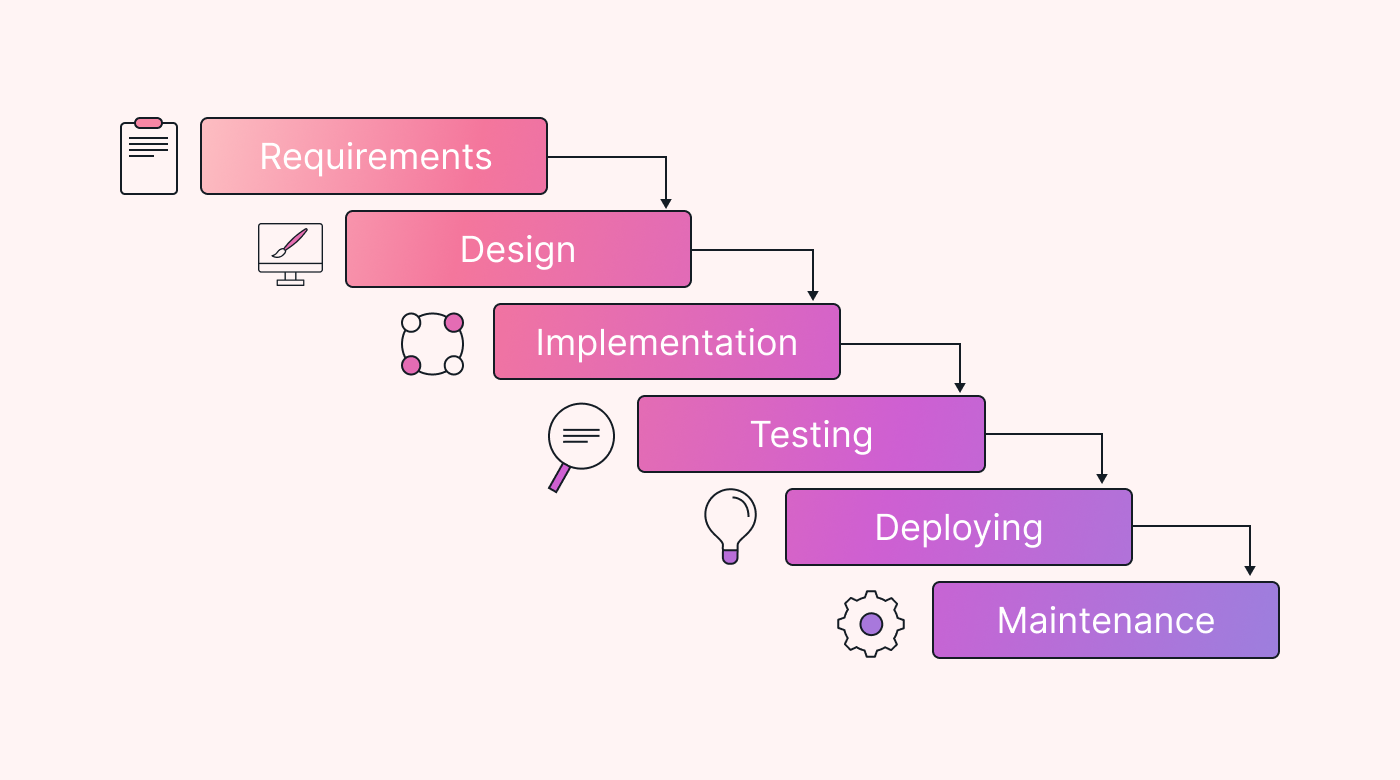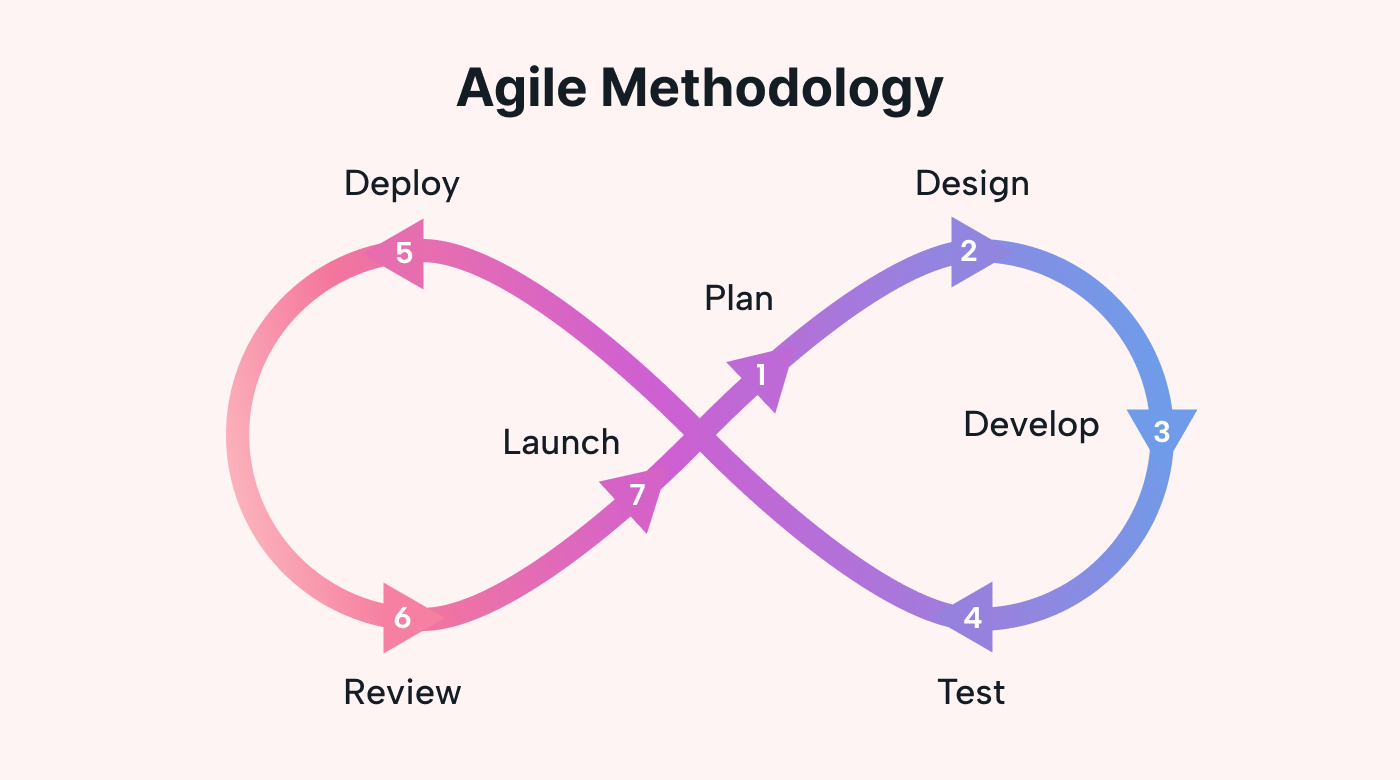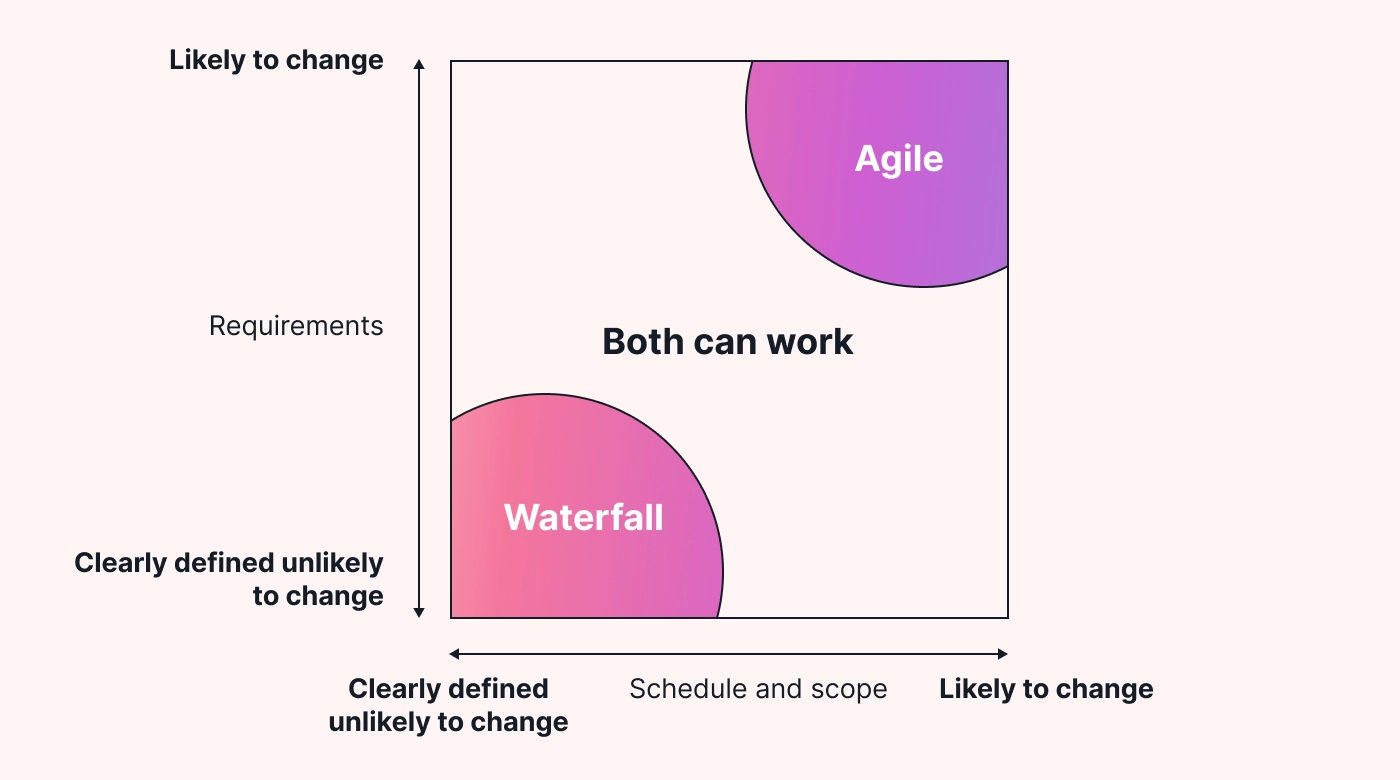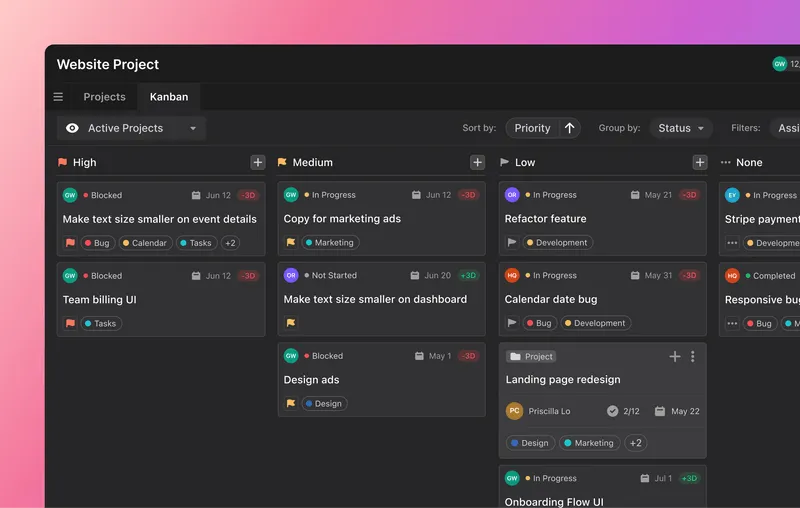When it comes to project management frameworks, two major philosophies dominate the conversation: Agile and Waterfall.
While both ultimately aim to deliver successful projects, their approaches are fundamentally different.
Waterfall follows a rigid, linear sequence of steps. It relies heavily on extensive upfront planning, strict processes, and a clearly defined scope from the start.
Agile embraces uncertainty and leaves ample room for change.
By developing in short, iterative cycles, teams can constantly reevaluate priorities and direction based on regular customer demos and feedback.
Let's take a deeper look at each methodology.
What is waterfall project management?
At its core, the Waterfall methodology is a linear, sequential approach to project management.
It follows a step-by-step process, with each phase building upon the previous one.
Think of it as a cascading waterfall, where progress flows steadily downward.

In the Waterfall method, projects follow distinct phases, such as:
- Requirements gathering
- Design
- Development / Implementation
- Testing
- Deployment
Each phase might have its own team and specific deliverables.
This method requires strong upfront planning and documentation.
It also requires a comprehensive understanding of the project scope. This way, the team can focus on staying within the boundaries and follow a clear path.
Unlike Agile, the Waterfall methodology follows a more rigid structure.
Once a phase is completed, it's challenging to make changes without going back a few stages.
This can lead to slower response times and limited client involvement at certain stages of development.
Pros & Cons of Waterfall
Let’s look at the pros and cons of “Waterfall style”:
- Pros
- Clear structure: makes it easier to plan and allocate resources
- Comprehensive documentation: provides a thorough understanding of project requirements and progress
- Predictability: well-planned in terms of timelines, milestones, and deliverables
- Cons
- Limited flexibility: makes it challenging to accommodate changes
- Lack of client involvement: can result in potential misalignment between deliverables and expectations
- Higher risk: due to its sequential nature, it can fail because of errors (which is why a clear scope is essential)
Now that we've gone over the Waterfall method and its pros and cons, let's now turn our attention to its agile counterpart.
What is agile project management?
The Agile methodology is a flexible and iterative approach to project management.
Unlike Waterfall, Agile focuses on collaboration, continuous feedback, and incremental growth.

Agile encompasses various frameworks, including Scrum, Kanban, and Lean. Each has its own unique attributes and benefits.
Scrum, in short, emphasizes self-organizing teams and short, time-boxed iterations called sprints.
It promotes close teamwork, clarity, and regular opportunities for adaptation.
On the other hand, Kanban visualizes work as it flows through different stages.
It does this using visual boards, so teams can easily monitor progress and identify bottlenecks. It promotes a steady and continuous workflow.
Lean was born from manufacturing and aims to remove waste and maximize value. It emphasizes efficiency, reducing unnecessary steps, and focusing on delivering customer value.
Agile teams foster teamwork, facilitate flexibility, and speedy delivery regardless of framework.
Pros & Cons of Agile
Let's jump right into the pros and cons of the Agile model:
- Pros
- Flexibility and adaptability: so teams can respond quickly to evolving needs and market demands
- Increased client involvement: to make sure deliverables align closely with expectations
- Early value delivery: because Agile projects work in short iterations
- Cons
- Potential for scope creep: because of Agile's flexible approach
- Resource management challenges: because it requires team members who can work well under pressure
- Less predictability: when compared to the Waterfall approach
Agile vs. Waterfall: key differences
Agile and Waterfall represent two distinct approaches with notable differences.
Let's look at some key differences.
Planning
Waterfall relies on tons of upfront planning before development begins. In contrast, Agile is more dynamic, using iterative cycles to adapt as the project progresses.
Flexibility
In Waterfall, each phase should finish before moving forward. Agile champions flexibility, with the ability to adjust to changes and refine.
Feedback loops
Waterfall methods sometimes limit client engagement at early planning stages. They also have minimal opportunities for feedback throughout the project. Agile principles foster frequent feedback and collaboration at every stage, leading to better outcomes and client satisfaction.
Adaptability to change
Waterfall requires a rigorous change control process. Changes can require extensive rework and potential delays. Agile workflows allow for continuous adaptation and quick reactions to evolving requirements.
Risk management
Waterfall methodologies prioritize risk mitigation through comprehensive planning and documentation. Agile methods aren't always as effective at addressing risks.
When to choose Agile vs. Waterfall
Waterfall: best for predictable paths
When your project has a clear map from the start and you know exactly where you're headed, waterfall is your go-to guide.
Here are scenarios where this method shines:
- Clear requirements: If your project has a clear deliverable from the start — like if you’re building a house from a set of plans — waterfall is your best choice.
- Deliverable usability: If the whole result needs to be there to make it useful at all, choose waterfall (like the bridge example).
- Strict phase dependencies: In projects where the next phase relies on the previous phases, like in manufacturing, where production can't start until the design is finished, waterfall is a natural fit.
- Linear projects: Waterfall is well-suited for projects where the sequence matters and doesn't change much. For example, if you’re paving a road, you can’t lay asphalt until the base layers are shaped and compacted. If you changed this sequence, you wouldn’t be paving a road, you’d be making a mess.

Agile thrives in evolving terrains
If your project’s scope might change based on new discoveries or shifting conditions, Agile is like the trusty compass that can keep you moving in the right direction. Consider these situations where Agile stands out:
- Evolving project requirements: Imagine your development team is designing an app. Users might want different features or changes once they try it out. With Agile, you can easily make those updates based on their feedback.
- Quick adaptation: In fast-changing industries, like tech, where new gadgets pop up constantly, like the stock market, Agile helps you stay on your toes. It lets you react quickly to whatever comes next.
- Continuous feedback for customer satisfaction: Just like a chef tastes food while cooking to make it perfect, the Agile method is well-suited for projects where stakeholder and customer feedback is critical to refining and delivering the best end product.
Whichever project management methodology you choose boils down to the nature of your project and what you hope to achieve.
But remember, it's not about which method is "better" but rather which is the best fit for your specific project. Equip yourself with the right approach, and your path to success becomes that much clearer.
Choices beyond Agile vs. Waterfall
While Agile and Waterfall methods are the typical choices, there are other choices that can combine them and maximize the capabilities of each.
Using hybrid methodologies
When an organization is developing products more suitable to waterfall, where the product must be delivered as a whole, all at once, such as a building, embedded software, or a highway, waterfall is best. When it is developing a product that can be delivered and used in modules, such as user software, agile may be a better choice.
Hybrid works well when dealing with some scopes that need the full scope designed before building, while also needing to produce elements that have evolving requirements. Many organizations make both kinds of products. They may use an agile approach for some projects and waterfall for others.
Sometimes even a single project may use a hybrid methodology combining Agile and Waterfall elements. That could be the case, for example, when a project needs to deliver both hardware and software. It might use waterfall for the hardware and agile for the software.
Practical tips for transitioning between methodologies
Transitioning between methods can present certain challenges. However, with the right approach, you can navigate this change successfully.
Here are some practical tips to guide you through the transition:
- Check your team's familiarity and experience with the new methodology. Offer training and support so that everyone understands the principles and practices involved.
- Create a well-defined transition plan that outlines the switch's steps, timelines, and milestones. Clearly communicate this plan to your team to set expectations and build consensus.
- Begin with a smaller-scale project to test and familiarize your team with the new methodology. In this way, they can learn and adjust before implementing it across larger projects.
Using project management tools to support methodologies
Using project management tools can enhance the effectiveness of any methodology. These tools provide features such as:
- Task tracking
- Collaboration
- Reporting
- Prioritization
- Scheduling
They can streamline most project management processes and improve overall productivity.
Remember to align the chosen method with your project goals, team dynamics, and constraints.
Motion makes Waterfall and Agile easy
Motion is a versatile tool that supports both Waterfall and Agile methodologies.

With Motion, you can effortlessly adapt the Waterfall method to fit your project's unique requirements. It has customizable task features to define stages, set dependencies, and track progress. It also gives a visual presentation of your project timeline and milestones to help you stay on track.
On the other hand, if you use the Agile methodology, Motion can support your iterative workflows. It has a flexible task management system, Kanban boards, and collaborative features. With Motion, you can visualize and prioritize tasks, manage backlogs, and facilitate smooth sprints.
Besides supporting most methodologies, Motion offers a wide range of features that can help you attain success. Motion offers an AI-powered calendar and task manager that brings numerous benefits to teams.
The AI calendar in Motion intelligently manages your project schedules and deadlines. It can manage optimal timing of tasks, identify and address potential scheduling conflicts, and help allocate resources.
With its assistance, you can create realistic project timelines and reduce the risk of bottlenecks and delays.
The task manager in Motion takes productivity to the next level. It employs AI algorithms to prioritize tasks intelligently. It does this based on deadlines, dependencies, and resource availability.
This guarantees that team members focus on the most critical and time-sensitive tasks. It also boosts efficiency and lowers time wasted on low-priority tasks.
These features automate repetitive and mundane tasks. This frees up valuable time and energy for more strategic and creative work.
The bottom line
Ultimately, both Agile and Waterfall methodologies have their merits—the key is understanding which approach best aligns with the unique parameters of your specific project and organizational needs.
For projects with relatively stable, predictable requirements and a need for firm processes and planning, the Waterfall method can provide structure and control costs.
But if you require flexibility, want to embrace change, and need extensive customer collaboration, then Agile's adaptive approach will likely serve you better.
Many teams today are exploring hybrid models that blend elements of both philosophies, essentially customizing processes to get the best of both worlds.
By combining the structured planning of Waterfall with the flexibility and customer focus of Agile, organizations can create a tailored approach that meets their unique needs.
No matter which direction you go, having the right tools to manage your workstreams, resources, and deadlines is crucial.
Platforms like Motion leverage AI-powered scheduling to automatically match workloads with resource availability across your entire team.
Its predictive insights can foresee potential roadblocks or delays weeks in advance so you can course-correct proactively.
Utilizing advanced project management tools can enhance your team's efficiency and effectiveness, regardless of the chosen methodology.
Whether you ultimately opt for Agile, Waterfall, or something in between, make sure you have the right framework and tools in place to set your teams up for success.
With careful planning and the ability to pivot as needed, you can deliver winning results for your projects and customers.

Tiffany has a BA in Business Management and years of experience writing for SaaS and digital marketing blogs. She bristles at typos, broken links, and 2015 statistics circulated through 2023 content. When not writing, Tiffany's either reading, baking, or mothering her spoiled rescue pittie.




